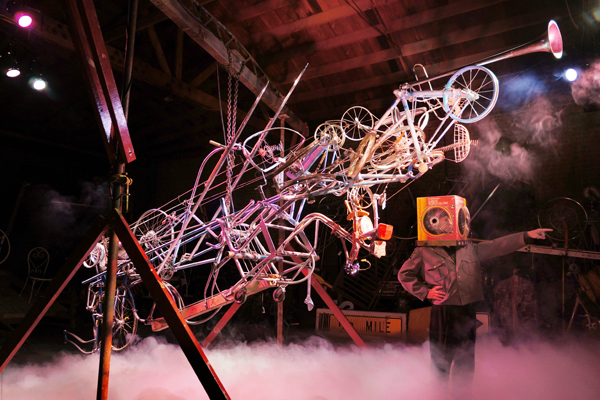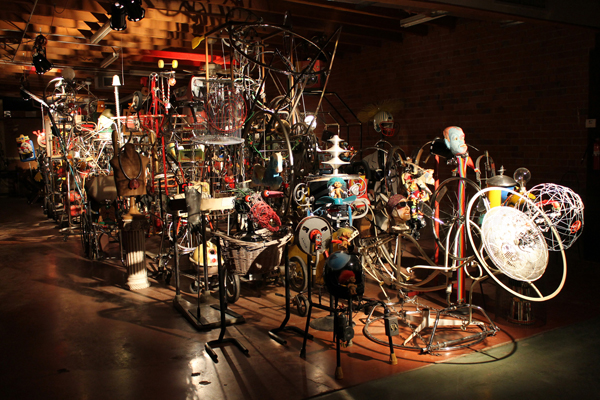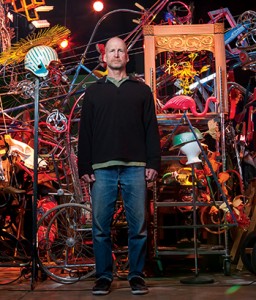Ark D’Bevel Docks; Sets to Disembark
“The primary concept, or underlying reality, of the science of our day is Relativity. Einstein added the fourth dimension to those of Newtonian physics: time. Therefore, the art of our day that incorporates time, or movement, motion, change, is the most vital of all the arts being created. It is the art of our time which will endure.” – David Bermant, 1919-2000

Mat Bevel’s General Boxhead with the Far Gun. Photo: Toshi Ueshina
Ned Schaper meets me outside of the Stone Dragon Gallery – easily identified by the large “TUCSON” mural painted on its south facing wall. It’s about a half block, dusty alley drive, north of Speedway Boulevard along Stone Avenue. Schaper smiles a hello into the beating sun and swirling dust. His countenance is lighter this time. Last time we spoke, in December 2013, he was pulling up anchor from his previous 17-year home/creative space in the Mat Bevel Institute at 530 N. Stone Ave., and was a bit weighed down and still unclear about where to float his ark – which is comprised of his 30-year body of work.
Six months after meeting with Ned Schaper last December and three months since he docked his ark, Schaper and I are catching up on his art, upcoming shows and how ultimately, he relies on faith to expose his purpose. His buoyancy is palpable when recounting the story of how building owner Steve Murray offered interim housing to the kinetic art sculptures at Stone Dragon Gallery.
“Sometime after that (Zócalo) article come out, I was actually on my way out of the building to walk up here to see Steve and he pulled up to my place. And then he’s looking at it all, saying, ‘We can keep some of this stuff at my place.’
“Steve really came through. He’s a good friend and we’ve known each other for a long time too. He believes in my work and told me – ‘When you leave that place, you are going to blossom. That was like a cocoon you were in.’ And everyone loved me being in that space, but it was not really what I needed for the next step in my career. As a career move, because it is a beautiful space and I was able to build all of this stuff, but you’ve got to bring people in. After 17 years, you are in this place, and you know, ‘Well, I’m not going to take any place else because it is great in here,’ but it’s too much trouble, no body’s coming in here. There’s really no money, to bring people in, I don’t sell things. I was sort of stuck. This here is great because I’m able to see it, able to see what I have.”
As Schaper turns on various lights, his sculptures are illuminated in ways that weren’t possible at the Stone Avenue warehouse. In Murray’s space, under bright florescent bulbs, Schaper has made repairs, tweaks and re-worked the kinetic souls/Beveldom’s citizens in preparation for their July show situated as the Ark D’Bevel at Stone Dragon Gallery, 1122 N. Stone Ave., and as a disassembled show spread throughout the Tucson Museum of Art, 140 N. Main Ave., in August.
As Ned Schaper explains through the character of Mat Bevel, “The museum of kinetic art was founded on the principle of Available Resource Technology. For 27 years, objects appeared at our doorstop. By utilizing the A.R.T. policy, we give new purpose to unwanted items.”

The Beveled Ark in Stone Dragon Gallery. Photo: Ned Schaper
“That’s what Mat Bevel is,” Schaper elucidates, “the things that people threw out, he created this whole world that then becomes all these characters, and all these words of wisdom that they gave through putting these things together. It’s a very timely sort of story. There’s the demolition, exodus and now all these unwanted items are homeless again. So now they are all homeless, floating around in this ark in town. So, the idea is we pull up to the Tucson Museum of Art with the ark and spread it out. The truth is I had to really think about arranging things according to voltage. I’ve got technical issues that other people don’t have. My biggest thing is – how do these things come on and go off?”
The beauty of Schaper’s work is not only the creative amalgam of married “junk” and the seeming whimsy of the pieces – in reality, there are deeply symbolic tales surrounding the characters in his body of work – but also the cool physics behind how the sculptures move. He shows how his six-foot tall butterfly works: “This is a perfect piece to watch kinetic energy because it runs off of this little dinky, six volt battery. This is a science project right here. And, it starts the flywheel up and people see that little motor could never run this whole thing. It’s a little dinky motor and a six volt, and how the heck? – it’s the flywheel, and you can see when I turn it off, it takes almost 40 seconds for it to stop. The flywheel is storing energy, that’s why they used flywheels in the old days.”
As we talk about the different characters and how the objects morphed together to make them, a greater sense of purpose and mysticism comes through. “The things come to you,” Schaper explains. “The idea is, when people see this, you don’t have to say anything. That’s why found objects are so great. The kids are just inspired, they realize, ‘I’ve got those things.’ All you gotta do is start putting them together, and once you start putting them together – a lot of junk artists feel the same way – they’re like, ‘I needed this and it shows up.’ When you really start working and you become a servant of them, these things start flying at me. I mean, people will knock on my door at the right second to give me stuff. It’s unbelievable, the magic that happens in the world when you stop trying to direct and that’s the basic difference in the world. And the whole idea of faith-based thinking should be the idea that, you’ll hear people say – ‘Dear God, I don’t know what’s going to happen, but please give me some sort of a signal.’ Well, that’s not what they teach at the university. That’s actually the right way, but we’re taught in our modern times that it is superstitious or something.”

Ned Schaper
For Schaper, his philosophy is informed by his experience of objects arriving and circumstances changing as they are needed. The source he culls from to create his kinetic sculptures lends itself to re-purposing what has been discarded.
“These things are always blessed, they’ve been brought back in the service of having another job in theatre; an exercise bike, a wheelchair. And now they are back at work, and that’s what God wants, for everything to be – I say, ‘Continuation of purpose is the unifying principle of the universe.’ And these are things that I’ve discovered, and it’s the truth. It goes beyond recycling. The truth is – things don’t like to be idle.”
The summer’s first exhibit of The Beveled Ark: Mat Bevel’s Museum of Kinetic Art displays at Stone Dragon Gallery, 1122 N. Stone Ave., from Friday, July 11-Friday, July 25, with opening receptions on Friday, July 11 and Saturday, July 12 from 4 p.m. to 8 p.m. Other hours are by appointment by calling 405-5800 or 304-8899.
For the Tucson Museum of Art Welcome to Beveldom: Mat Bevel’s Museum of Kinetic Art show, running from Saturday, August 9 to Saturday, September 28, the ark will disembark throughout the museum’s exhibition spaces in interactive displays.
Schaper admits surprise when he was asked to exhibit at the museum. “The fact that I am in the museum is pretty absurd. That I’m given a one man show is quite a miracle and I can’t complain. It is quite the miracle because I don’t do galleries. I love working with Julie (Sasse, Ph.D., Chief Curator and Curator of Modern and Contemporary Art at Tucson Museum of Art). She told me she thinks that, ‘Your work is important; it is an important body of work.’ So she thinks what I do has a place historically.”
Via email, Sasse says that she has been interested in Schaper’s work for some time and the idea for the exhibit has been in the works for about a year. “Once the opportunity presented itself, I got the exhibition on the schedule.
“Schaper’s art is playful yet intellectual and deeply involved with issues of today. It is engaging for all audiences and he shows a true commitment to his vision. For the extensive body of work he has amassed and the long history of producing quality works in this community, he was long overdue for some critical attention. He truly deserved to have an exhibition in Tucson and his work shows that progressive and exciting art is being produced in this area. In fact, I’m surprised he hasn’t been discovered beyond this area, so I’m glad the Tucson Museum of Art can share his art with the public both here in the city and beyond.”
Sasse also says that she hopes the show’s attendees can appreciate “that meaning can be found in everything and that the creative spirit is as broad as we can make it if we use our imaginations. A good work of art can go far beyond a landscape or a still life or pure abstraction — it can be a playful yet thoughtful look at the world – that’s what Mat Bevel brings to the art table.”
Regarding her personal take on his work, Sasse writes, “I think he is a bit of a local genius the way he puts objects together and makes them move. But just as important, I’m amazed at how he thinks in such a clever way — his puns always make me laugh and I appreciate his sharp wit regarding systems of power.”
“Welcome to Beveldom” shows at Tucson Museum of Art, 140 N. Main Ave., Aug. 9-Sept. 28 with performances of the Beveled Ark Theater variety show on Thursday Aug. 21 and Sept. 11, from 6-8 p.m. Find more information at TucsonMuseumofArt.org and MatBevel.com.
Category: Arts, Community, DOWNTOWN / UNIVERSITY / 4TH AVE




